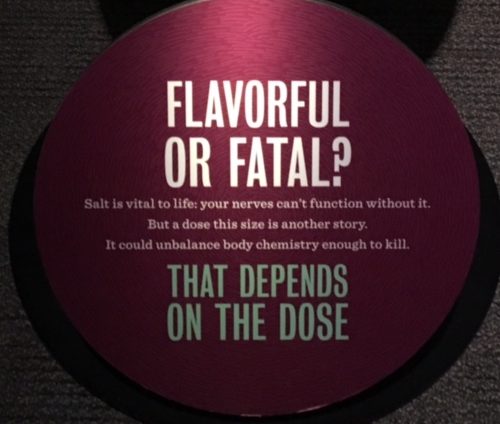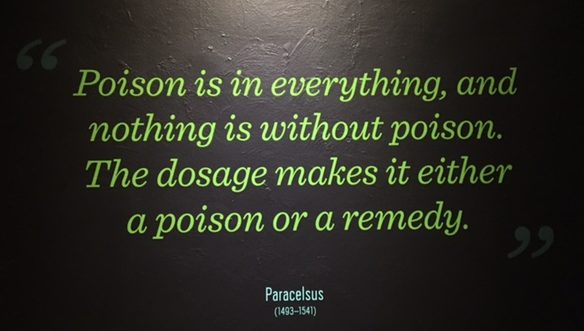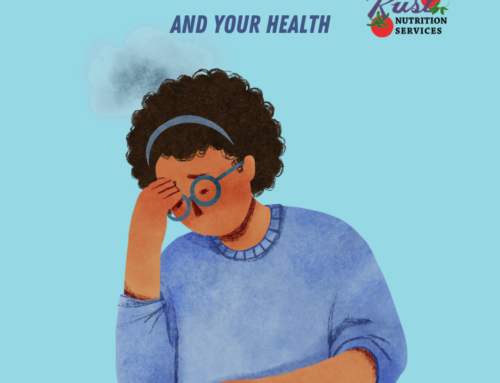Two words I hear often, “Fear sells”.
Is fear guiding your food choices? Whether it is an environmental issue, a political topic, or the safety of our food supply, fear-mongering has become a common technique used to sway you into believing one side of a story. Usually it’s done by sharing some facts either out of context, or without full background.

photo credit: Rosanne Rust source: Carnegie Museum of Natural History, Poison Exhibit, Pittsburgh, PA
Much of the worry about chemicals used in food processing, or chemical residues that may occur within our living environment, is viewed without consideration for the amount of exposure, nor the safeguards already in place. There is no possible way we can live in our modern society without exposure to chemicals in the air, water, or soil.
Exposure doesn’t mean toxicity.

photo credit: Rosanne Rust source: Carnegie Museum of Natural History, Poison Exhibit, Pittsburgh, PA
When I was in grad school, I had to take a toxicology class. It was a fascinating class, and helped put in perspective the basic toxicology principle of “The dose makes the poison”, and how it applies to almost any chemical substance in our environment.
How to Spot a Fear-Monger
There’s been a lot of news of late about the issue of pesticide residue in our food supply, and the headlines are generally created to worry you. As you read the headlines about food or nutrition, there are a few questions you may ask yourself:
- Does this news sound overly shocking?
- Are pictures or emotional images used? If there are no pictures, it’s likely the news is more fact-based. If an image is used (such as a sad child, cross bones, or food with needle in it), read closely. Images like these are often used to create emotion and divert you from all of the facts.
- What facts might be missing? Does it seem like this is only “one side of the story”
- Are you knowledgeable on the subject at hand. For instance, if it’s an article about genetically modified plants – are you familiar with plant biology? If it’s about chemical residues in our environment – are you familiar with toxicology principles?
Recent News about Pesticides in Cereals
A lot of Americans enjoy cereal for breakfast. The Environmental Working Group (EWG) recently published a misguided report suggesting that your morning cereal could contain pesticide residue. The EWG is an organization that is expert in using the fear-mongering technique. They want to live in a world where all farms are small and organic, and where households only use vinegar as a cleaning agent. They also perpetuate a lot of myths about cancer, lifestyle and diet and offer misguided advice about pesticide risk in produce, and mercury levels in seafood.
While the EWG has criticized the USDA Dietary Guidelines for Americans for being “influenced by the food industry”, the EWG itself has clear ties to the organic food industry (they collaborate closely with the Organic Voices Action Fund, which represents organic brands including Stonyfield®, Earthbound Farm®, Organic Valley®, Nature’s Path® and Annie’s®). Kinda hypocritical no?
The latest EWG report titled “Breakfast with a dose of Round-up” is a prime example of how to use fear to make your case or sway your audience. Despite the fact that their report contained residue samples from 21 food products, they chose to highlight the products from “Big Food” companies – General Mills®, Quaker® (PespsiCo®) and Kellogg’s® – in their headlines and “call to action” (even though other brands such as Bob’s Red Mill®, Back to Nature® and Great Value® were also reviewed). Worse, they used the popular brand Cheerios® as their poster child for this misguided report, seemingly intentionally to scare mothers of young children.
Science, Standards, and Common Sense
The EWG tends to use their own science, and in this case, the state of California’s guidelines, about pesticides. So let’s look at some facts.
- The products tested were oat-based. The EPA has a system in place to determine safe levels of pesticides and other residues that occur in our environment, including safe tolerance levels for grains.
- The tolerance level of glyphosate residue (including its metabolites) in grains (including oats) is 30 ppm (parts per million), or 30,000 ppb (parts per BILLION). The results from the EWG testing were in parts per BILLION. So doing the math puts this in perspective as you compare a safe level of 500 ppb to the 30,000 ppb threshold set by the EPA.
- I see some inconsistency in the EWG report. Why were some products tested once, others twice, and only four tested three times? Instead of averaging the results, they used the highest result to report (poor quality control in testing?).

This is where common sense comes in. The dose makes the poison – the presence of a “potentially toxic” substance does not equal “toxicity”. When healthy foods are taken off the table, family nutrition is going to suffer. Whole grain foods such as oat cereals, provide fiber and important nutrients to the diet. Fresh produce is also an important part of a healthy diet. Both are important to heart health. The EWG instills fear leading some consumers to not purchase these healthy food items. I encourage you to use The Alliance of Safe Food and Farming calculator and guidelines to you can enjoy adding more produce in your weekly grocery cart. In regard to enjoying grain foods, the Whole Grain Council is an excellent resource for facts.





[…] food as nourishment. It is not toxic. Choose to plan meals based on both nourishment and enjoyment. Respect your personal food […]
[…] written about risk and hazard, and how “the dose makes the poison” before, and I could write more about the EWG’s new list, but I have several colleagues who […]